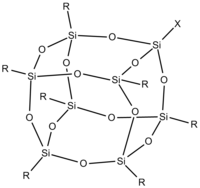
Photo from wikipedia
In this study, energy and entropy analysis of a residential-type direct absorption solar collector using hybrid Fe3O4/SiO2 nanofluid is evaluated experimentally. The hybrid nanofluid samples are prepared in the different… Click to show full abstract
In this study, energy and entropy analysis of a residential-type direct absorption solar collector using hybrid Fe3O4/SiO2 nanofluid is evaluated experimentally. The hybrid nanofluid samples are prepared in the different volume ratios of Fe3O4/SiO2 (25:75, 50:50 and 75:25) and different volume fractions (500 ppm, 1000 ppm and 2000 ppm). The appropriate nanofluid samples for using as the working fluid of the collector are chosen based on the results of stability and optical properties of nanofluid. Then, outdoor thermal performance of collector is investigated using the experimental setup based on EN12975-2. Measurement of nanofluid optical properties using the spectrophotometry method shows that the extinction coefficient of 2000 ppm hybrid Fe3O4/SiO2 nanofluid is on average 10 cm−1 higher than that of the base fluid. Results of energy analysis display that the collector efficiency is increased by mass flow rate and volume fraction of nanofluid asymptotically. The asymptotic value is about 83% for 2000 ppm hybrid Fe3O4/SiO2 nanofluid. The findings indicate that the variation of exergy efficiency of a direct absorption solar collector with the volume fraction and mass flow rate is similar to energy efficiency. The enhancement of exergy efficiency is 66.4% for mass flow rates of 0.0225 kg s−1 by increasing the volume fraction from 0 to 2000 ppm. It is also observed that dimensionless entropy generation number is decreased by nanofluid volume fraction and by mass flow rate. The lowest entropy generation number is obtained in the mass flow rate of 0.0225 kg s−1 and the volume fraction of 2000 ppm. The variation of Bejan number by volume fraction shows that the contribution of pressure drop in entropy generation is insignificant.
Journal Title: Journal of Thermal Analysis and Calorimetry
Year Published: 2018
Link to full text (if available)
Share on Social Media: Sign Up to like & get
recommendations!